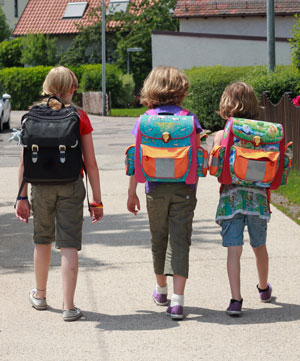KANBrief 1/16

Ensuring that children can be seen by road users on their journeys to and from school helps to prevent accidents. This in turn is in the interests of the German Social Accident Insurance Institutions for the public sector. Safety is enhanced by satchels with adequately large reflective and fluorescent areas as required by DIN 58124. These high-visibility areas are however evidently "uncool". Consequently, satchels are increasingly being sold that fail to meet the standard.
Stiftung Warentest, the German consumer association, deems satchels "poor" when they lack adequately large reflective and fluorescent areas (Test Report 03/2013 (in german)). DIN 58124, "Satchels – Requirements and testing", specifies that at least 10% of the rear and side surfaces of a satchel must be fitted with retro-reflective material. This increases visibility during the hours of darkness when a vehicle's headlight beam falls upon the satchel. Reflectors do not enhance visibility in daylight; fluorescent materials assure adequate safety in this case. These are in the familiar orange/red or yellow of high-visibility jackets, and are consequently also highly visible. DIN 58124 requires 20 percent of the satchel area to be fitted with these materials.
Whereas reflectors are widely fitted to satchels, some manufacturers fail to provide the fluorescent areas that would enhance visibility during the day and at dusk. The designers evidently have difficulty reconciling pink princesses or dark dragons with the colours specified in the standard. It follows that when choosing a satchel, primary-school children and their parents are increasingly driven by the desire to be "cool" rather than by safety. Advertising may also convey the impression that safety is adequate even though a satchel fails to observe the standard.
What is product safety?
The market surveillance authorities have difficulty taking action against such satchels, however. The German Product Safety Act states in general terms that products may not be placed on the market if they endanger the safety or health of users. Standards listed in the Common Ministerial Gazette describe in detail how this general requirement is to be interpreted. DIN 58124 is among the standards listed in the gazette. However, it is debatable whether this listing is in any sense justified for the aspect of the visibility requirements (DGUV Forum 10/11, p. 19-21, pdf, in german). Opinions differ concerning whether a satchel must feature warning functions in order to take comprehensive account of external sources of hazard such as cars and other road users.
A consensus exists that the authorities may take action when a manufacturer claims that his product satisfies the DIN standard when in fact it does not. Irrespective of the legal arguments for and against, schoolchildren are not obliged to use satchels; they remain entitled to use rucksacks or bags instead.
Revision of the standard presents opportunities
DIN 58124 is now being revised as part of the regular adaptation to the state of the art. This revision presents an opportunity for ways to be found to combine the requirements of design and visibility more effectively. For example, could fluorescent pink, used over a wide area, result in good visibility values? Would LED-powered flames also produce a more convincing dragon? Must the reflective and fluorescent surfaces be contiguous, or could visibility equally be enhanced if contours were given greater emphasis?
Attention should also be paid to the ergonomic requirements during revision of the standard. The ergonomic design of a satchel is a product property that falls under the Product Safety Act, and may therefore be relevant to subsequent listing of the standard in the Common Ministerial Gazette.
To provide answers to the open questions, it is important for safety experts – for example from the statutory accident insurance institutions, consumer bodies and the authorities – to be actively involved in revision of the standard. At the same time, the committee for product safety (AfPS), which decides whether the revised standard is to be officially listed, should also observe the revision process. It would also be advantageous for awareness to be raised among parents, schools, and other responsible parties for the selection of suitable satchels. Together with its partners, KAN is lobbying for these aspects.
Werner Sterk
sterk@kan.de